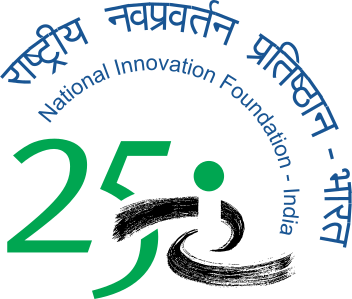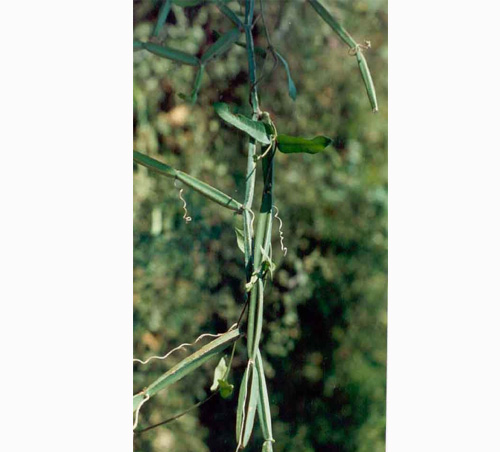Traditional bone healer
Pushpalata Saikia (40) hails from Pangria, a remote village in the Jorhat district of Assam. She has been practicing a traditional method of treatment for bone fracture and backache successfully for years. She treats nearly 20 to 30 patients daily and charges no fees. She has learnt the practice from her husband late Sidanand Saikia and her brother in law Dulal Saikia. She has not made any improvement over the practice. She has treated more than 500 patients and cured 95 percent of the patients suffering from bone fracture.
Method of preparation The leaves/stem of Harjura lota (Cissus Quadrangularis linn) (25 g), leaves/stem of Pochotiya (Vitex nigunda) (25 g), leaves/stem of Kehraj (Vebesina Prostrata) (20g) and leaves/stem of Kolialota (Merremia umbellate) (25g) are taken and all of them are mixed and oil seeds (10 g) are added to this mixture. The mixture is then ground and boiled to get a composition in the form of solid paste. These materials are available in the jungles- some plants are only available during summer and some are available during winter.
A family tradition
There have been numerous traditional ways of curing broken bones all over the world and the Saikia household in Assam is one of such families who have been practicing it for 6 - 7 generations now. The contents of the herbs, which are used for the treatment and its preparation is not known to anyone except a few members of the family. The person in knowledge of the contents of the herbs generally reveals it to the eldest member of the family on his/her death bed. It is so secretive that the girls born in the family are never told about the exact specification of preparing the medicines and its application. The reason is that they will get married and leave for their husband’s home and thus it will no longer remain a secret. Though girls married into the family are told about the herbs, it is done only when there is no adult male in the house. Pushpalata Saikia had come to know about the practice from her husband late Sidanand Saikia and her brother in law Dulal Saikia.
The intriguing story behind this medicine There is a story regarding the founding of this medicine. Non-vegetarian food such as fish, egg or meat of duck, chicken and even pork is common among the people of all satras of Assam. Sometimes pigs are sacrificed on certain festive occasions and at such times the entire village eats the pork after the ceremony is over. The discovery of this wonder drug started from this “sacrificial pig” and the great grandfather of the present generation of the Saikia household was the one who discovered it. Around 100 years ago, on a festive occasion a pig was sacrificed. Since it turned dark on that particular day due to a delay in the proceeding of the rituals, the villagers thought that it would be better to keep it in the Dekhi Ghor (Paddy store house) overnight and distribute the pork on the next day. They covered the cut pig that had been slashed open longitudinally in the stomach with different kinds of leaves. The next day when the villagers came to distribute the pork around the village they were aghast to see that the wounds of the pig had healed miraculously. They all ran away thinking that it was the handiwork of some departed soul or may be a ghost.
But the elderly Saikia, though surprised to see the miraculous healing of the sacrificed pig, was not intimidated by the incident. After pondering over it for days he came to the conclusion that may be there was some medicinal property in the leaves, which were used for covering the sacrificed dead pig. He started searching for the same kind of leaves in his backyard, the village and also the nearby forest. After he was satisfied that the leaves he had collected were the same as the ones used to cover the dead pig he took a goat of his and deliberately broke its leg. Then he started to bandage its broken leg with the leaves and after many trials he successfully found out the right ones and also refined the dosage. All throughout this experiment of his, the people of the village called him names and tried to discourage him from doing it but he didn’t let that deter him. Before his death, he called his eldest son and told him about the herbs and the application. He also told him to use it for serving society and not for earning money. He also ordered him not to divulge it to anyone outside the family excepting inside their household and laid down certain rules and regulations for passing the information down to the next generation as mentioned above. This shows that he was very concerned that this practice should be used for service and not for exploiting people. These rules are followed with all its strictness till the present generation.
Method of administration
In order to treat a person the paste so obtained is applied on the affected area of the body or wound and allowed to remain there for a period of at least 24 hours. The medicine should be applied on the affected area and covered with a calcium plaster sticker, above which a cloth is to be tied. The medicine should be allowed to remain on the affected area for exactly 24 hours. The application should not be tampered or otherwise it would turn ineffective. This treatment is useful for the removal of pain, backache, healing of minor bone fracture, painful conditions of frozen shoulder, stiff neck, Kolialota (Merremia umbellate) (25g) are taken and all of them are mixed and oil seeds (10 g) are added to this mixture. The mixture is then ground and boiled to get a composition in the form of solid paste. These materials are available in the musculoskeletal disorder and post operational pain. In case of a fracture the herbal composition has to be applied every three days for a period of one to four weeks depending on the nature and severity of the fracture. Instead of placing the broken bone in its original place, the application is said to elongate the bone and then join the broken area. This is the reason cited for taking out the application after exactly 24 hours.








